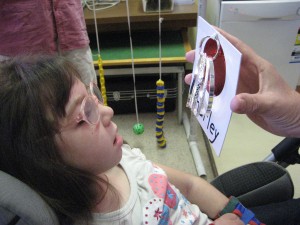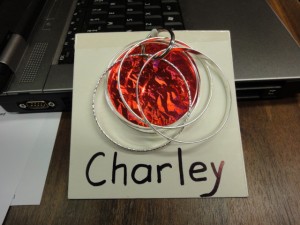Charley is just beginning to use her vision to engage in what is happening around her.
Robin Stesel describes how in collaboration with Charley’s family, Charley’s visual preferences were recognised and used to support visual engagement using personalised tactile symbols.
Recognising Charley’s visual preferences
For the first 12 months I visited Charley once a week at home. Charley was introduced to a variety of auditory, tactile and visual objects to find out if she had any particular sound, texture or colour preference.
Initially Charley appeared to prefer bright flashing lights, hard surfaces and loud noises. Over time she started to show no response to the flashing lights showing more of a visual awareness for the colour red. It was also observed that when we used the bright shiny red colour and movement, Charley was able to visually attend to an object more consistently.
We also observed that Charley responds by smiling to familiar events and objects in her home environment and that she was a “bling” girl (her mum’s description) as she wore jewellery every day.
Building on Charley’s preferences
To begin to support Charley’s understanding of the world around her, we used her preferences to create simple objects to encourage Charley’s attention. A name card for Charley was constructed, using silver bangles and a red circle of shiny paper (fig. 1).
The name card was introduced to Charley each time she arrived at playgroup and during songs where Charley’s name was included.
Charley’s name was also spoken as it was presented. This consistent approach enabled Charley to use multiple senses together – touch, vision, and sound, to gain information.
On the presentation of the card, Charley was supported to begin to explore her name card with sensitive hand-under-hand support (figure 2).
As the weeks progressed, Charley became visually aware and attended to her name card when it was presented at midline, accompanied by her spoken name (figure 3). Charley now consistently responds by smiling.
In the second year, I made fortnightly visits to Charley and her family at their home and continued to work alongside Charley at the sensory playgroup, also once a fortnight.
As Charley becomes consistent in her response to her name card at playgroup, the next step will be to transfer this new skill to all contexts, starting with the home environment.
Teaching and learning strategies and adaptations
Through consideration of time, repetition and positioning Charley has become more consistent in her response. Her main response is by smiling but on occasion it appears that she is trying to lift her hand up.
- Time – it can take up to 15 – 20 minutes for Charley to respond.
- Repetition – repetition both in the home and playgroup environments.
- Positioning – being well positioned was important for Charley to visually attend to name card held at midline and at a distance of approximately 10-15cms.
Adaptations – use of white card, red shiny Dura-seal and a set of sliver bangles for Charley’s name card based on her preferences.
Useful links
- CVI definitions v.i.scotland website.
- ‘Non Verbal Communication: Cues, Signals and Symbols’ J.C.Durkel Texas School for the Blind 14 January 2010.
- Object cues – an introduction at the Project Salute website.
Professional resource
More information
Email us at BLENNZ Online to find out more information about this subject.
We will link you up with either the author of this post or another BLENNZ colleague with whom you can continue your conversation.



